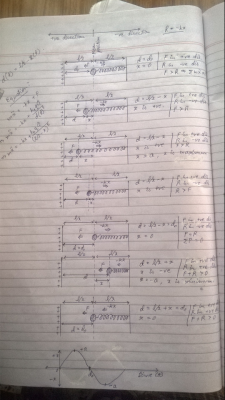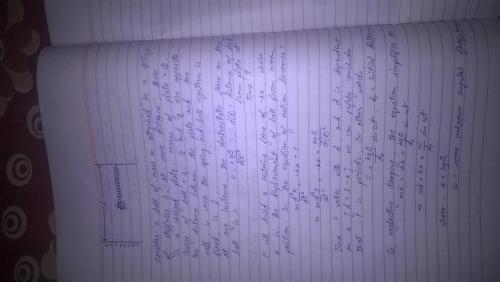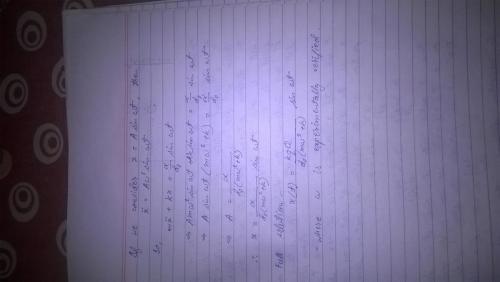-
Posts
623 -
Joined
-
Last visited
Content Type
Profiles
Forums
Events
Everything posted by Sriman Dutta
-
Today I learnt how to solve second order linear non homogeneous differential equations. ;-)
-

A logical approach to gravity at the quantum level
Sriman Dutta replied to mantraphilter's topic in Speculations
Mantraphilter, I would advise you to get some basic knowledge of physics and mathematics. -
As the others have said, the only thing I would say is that you should motivate yourself to learn yourself. Just don't abandon your hunger for knowledge.
-
Why do you find your school, friends and society boring??
-
Please explain what do you mean by a bridge between anode and cathode.
-
Initially the plate is uncharged. Then at that point the ball lies in its origin or original position or initial position. There no forces are acting. And I am considering that initial position as the reference . Displacement to the left of the initial position is considered as positive and on the other side it's negative. Then I introduce the charge on the plate. Due to this the ball will show a movement.
-
Here's a rough illustrations..... I want to know why you think that it isn't harmonic? I thought it as an example of forced vibration.
-
My fav is cricket. Anyone else with cricket fantasy???
-
Firstly the electric field will always point towards the plate, that is, the direction of electrostatic force remains unchanged. The restoring force acts in opposite directions with respect to the displacement x. This means that if the electrostatic force attracts the ball due to opposite charges, a positive displacement towards the plate occurs. However a restoring force acts in the opposite direction. The displacement towards the plate occurs as long as F>kx. But at the extreme position, when kx> F, the ball comes back. This continues and causes a negative displacement. This makes me think that the ball shows harmonic motion. Yes I doubt whether the F is sinusoidal or not. But magnitude of F is dependent on x, and if we write it like this F=kqQ/(l-x)^2, where l is distance of plate from mean position. But if I put this value in the equation, it becomes so tedious. Therefore I assume that F=kqQ/d^2 sin wt
-
Well I didn't turn them..... They were erect. But when I uploaded the pics they turned about. Now coming to the problem. A charged ball with charge q is attached to a spring of stiffness k. At some distance there is a charged plate, of charge Q. So as soon as the electrostatic force (q and Q are opposite) exerts a pull on the ball towards the plate, a restoring force builds up in the spring in the opposite direction. So the equation becomes [math] m\frac{d^2x}{dt^2}=-kx+F [/math] , F is the electrostatic force and m is the mass of the ball. x is the displacement of the ball about its mean position. But as the ball shows a harmonic motion, the external electrostatic force acting upon it is also harmonic or periodic in nature. Considering that F shows oscillations, the equation becomes [math]m\frac{d^2x}{dt^2}=-kx+\frac{k_e qQ}{d_0^2}sin \omega t [/math] Solving this yields [math]x(t)= \frac{k_e qQ}{d_0^2 (m\omega^2+k)}sin \omega t [/math] Here ke is Coulombs constant and [math]\omega[/math] is the angular frequency, experimentally determined. Am I correct??
-
Can someone help?
-
Yes. Khan Academy provides online courses. You can try them.
-
If you have the interest to learn physics, then visit a library and get the basics. I don't know how the education system in your country works. Can you get admitted to a university in a graduation programme?
-

List 100 anticipated inventions that havent been invented yet?
Sriman Dutta replied to Maximum77's topic in Homework Help
Theory of everything..... It's still not published, scientists are seriously anticipated about this, yet haven't got a good one. ToE should relate QM, relativity, string theories and all other hypotheses. -
You are correct. Note that the torque is a vector and has a direction perpendicular to that of force and radius vectors. Translational motion Newton's law: The force exerted by a body is directly proportional to the rate of change of linear momentum. Equation: [math]F=ma[/math] Equations of motion: 1. [math]v=u+at[/math] 2. [math]S=ut+\frac{1}{2}at^2[/math] 3. [math]v^2=u^2+2aS[/math] Rotational motion Newton's law: The torque on a body is directly proportional to the rate of change of angular momentum. Equation: [math]\tau = I\alpha[/math] Equations of motion: 1. [math]\omega_f = \omega_i + \alpha t[/math] 2.[math]\theta = \omega_i t + \frac{1}{2}\alpha t^2[/math] 3. [math]\omega_f^2 = \omega_i^2 +2\alpha \theta [/math]
-
-
Momma is so heavy that the amorphous graphite turns to crystalline diamond! I wonder what her weight might be!
-
The Stone Age primitive men didn't have any language. Yet they invented fire and wheels. This shows our brain doesn't require language to innovate. Einstein knew English. Yet he thought so many ideas. His language helped him to think so much. This shows that the language I'm presently using is fine for my brain.
-
If the question is read carefully, it will be found that the question demands the PRESSURE exerted by air , given that the atmospheric PRESSURE is 1.013*10^5 Pa.
-

Is this universe completely silent?
Sriman Dutta replied to Sriman Dutta's topic in Astronomy and Cosmology
Hmmmm.... I see . Moreover the sound of 13 MHz can't be detected by our ears. Our ears can detect only 20Hz to 20kHz. -

Is this universe completely silent?
Sriman Dutta replied to Sriman Dutta's topic in Astronomy and Cosmology
Ok. But those sounds can't be picked by our ears. I consider the human ear as the receiver. -
Suppose you are given the relation that [math] a^a= b [/math] . Then how you do you proceed to find a in terms of b ? Or, the solution doesn't exist.
-

Is this universe completely silent?
Sriman Dutta replied to Sriman Dutta's topic in Astronomy and Cosmology
Hmmm...... The density of our universe is too small and therefore negligible. So we can assume that the universe is silent. -
Hi, I got this question in my head....... Of course it seems quite true that there is no sound in space. But there might be exceptions. So is our universe completely silent??




